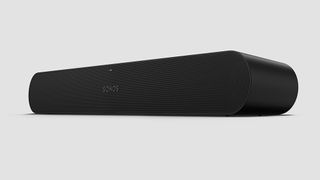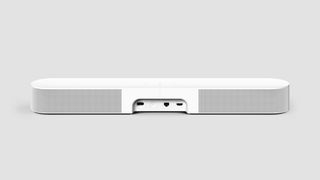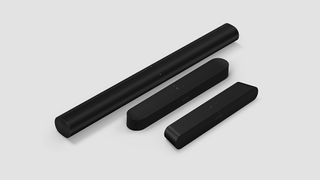Sonos Ray vs Sonos Beam (Gen 2): which is the best small soundbar for you?
The smallest Sonos soundbars battle it out

Sonos is known for excellent-quality audio tech for a good price – but not a super-cheap price. But its latest soundbar, the Sonos Ray, breaks the mold, because it’s both affordable and compact. The big question is: how does the Sonos Ray compare to the similarly compact Sonos Beam (Gen 2)? In this guide, we’ll put these Sonos soundbars head-to-head to help you determine which is best for you: the Sonos Beam vs Sonos Ray.
The Sonos Beam (Gen 2) is a mid-range soundbar ideal for small rooms. It comes with Dolby Atmos support, HDMI eARC compatibility, and a refreshed design over the original Beam, which launched a few years earlier. We found it had a powerful sound – bigger than its small size suggests – in our full Sonos Beam (Gen 2) review, and it fits into the broader Sonos ecosystem, of course.
However, although the Sonos Beam might not be expensive, there are more affordable options available. Enter the Sonos Ray. Like the Beam, it’s not the best soundbar for ridiculous room-filling surround sound. Instead, it’s for small spaces and small budgets, and it's pretty damn good with that in mind – here's our full Sonos Ray review.
You’re not alone if you think the Sonos Beam and the Sonos Ray sound similar. So what’s the difference between the Sonos Beam vs Sonos Ray? In this guide, we’ll help you weigh up the pros and cons of each soundbar.
If you like the idea of a Sonos sound system but you aren’t sure whether a Beam or a Ray soundbar is for you, then take a look at our guide to the best Sonos speakers.
Sonos Beam (Gen 2) vs Sonos Ray: price and availability
The Sonos Ray will be available to buy on June 7 for $279 / £279 / AU$399.
There are other budget soundbars available for under £300 / $300, including from some big names – but Sonos could well out-perform them for sound quality. We’ll have to wait until we review the Sonos ray to find out for ourselves.
The Sonos Beam (Gen 2) came out in October 2021 and costs $449 / £449 / AU$699. This means the Ray is now the cheapest Sonos soundbar, and might appeal to anyone who was keen for something like the Beam but couldn’t justify the price.
For comparison, the high-end Sonos Arc soundbar costs $899 / £899 / AU$1,499 – though it's much larger and is packed with speakers for directional audio.

Sonos Beam (Gen 2) vs Sonos Ray: design
The Sonos Ray is the smallest Sonos soundbar, and it’s ideal for TVs between 32 and 55 inches. It has a minimal design and tapered edges, a solid choice if you’re short on space.
The Sonos Ray and the Sonos Beam (Gen 2) look similar and are available in black or white. But the Beam (Gen 2) is recommended for up to 65-inch TVs, which means there’s a difference in dimensions and size.
The Ray is 559x71x95mm (wxhxd) and weighs 1.95kg. The Beam (Gen 2) is 651x69x100mm and weighs 2.8kg.
Although both soundbars can be placed on a surface or wall-mounted, some construction differences might influence how you use them.
All of the acoustic elements within the Ray have been designed to face forwards so you can put it on a shelf in a TV cabinet. However, the Beam’s design means it can project sound sideways too, for a wider soundstage. So although the Beam (Gen 2) can provide more immersive sound, the Ray will slot happily into pretty small spaces without limiting the audio.
Around the back of the Beam (Gen 2) soundbar is a port for plugging it into a power outlet and HDMI, optical, and Ethernet ports. However, the Ray’s only connection to your TV will be through the optical port, rather than the eARC HDMI connection we often see for soundbars. Sonos says this is to make it easy to set up and ensure it works with as many TVs as possible.

Sonos Beam (Gen 2) vs Sonos Ray: features
The Sonos Ray is almost half the price of the Sonos Beam (Gen 2), so it’s no surprise the Beam has more features. The most significant is that the Beam (Gen 2) comes with eARC compatibility, which allows the soundbar to handle more advanced audio formats, including hi-res audio codecs.
Unlike the Ray, it also has Dolby Atmos support for an immersive listening experience. However, it’s worth noting here that the soundbar doesn’t have upfiring drivers that you’d need for ‘true’ Atmos, unlike the more premium Sonos Arc.
Instead, the Beam (Gen 2) uses psychoacoustic techniques to give the impression of height from your movie soundtracks. We found the Beam had a remarkably wide soundstage and powerful audio performance for its size during testing. Still, we didn’t experience the exceptional overhead sound you get from the Arc.
The Ray is no-frills and has none of these features. It will not provide an immersive and powerful sound on par with the Beam (Gen 2). But instead, Sonos has worked to provide a wide soundstage here in other ways.
Using a split waveguide, the Sonos Ray can direct some of the high-frequency energy right towards you and directs the rest more towards the sides, adding the stereo effect, and making sure the sound doesn't feel like it's coming from such a small box.

With both the Sonos Ray and the Sonos Beam (Gen 2), you can boost sound by wirelessly syncing your soundbar with other Sonos products. For example, if you have a Sonos Ray, a pair of Sonos One SL rear speakers and a Sonos Sub, you can create a complete 5.1-channel home cinema system. Although this might not make much sense for those who opted for the Ray to save cash, it’s good to know you can seamlessly add more Sonos products later down the line.
Both the Beam (Gen 2) and the Ray use Sonos TruePlay to calibrate the audio output to its surroundings. During set-up, the soundbar plays noises across the frequency range. You then walk around your room with your iPhone, and the Sonos app uses its microphone to tune the soundbar's sound perfectly to fit the space.
Unfortunately, this feature is only available if you have an iPhone. Sonos says that it’s only to improve the experience and all soundbars still work well out of the box, but it’s still a shame for anyone with an Android phone.
Another difference is that the Sonos Ray has no built-in mic and, therefore, no Alexa and Google Assistant integration.
The lack of HDMI ARC also means that the Ray misses out on automatic volume control using HDMI-CEC. On the Sonos Beam, this means that from the moment you plug it in, the Beam will taken volume control commands from your TV's remote, without any extra fiddling.
On the Ray, however, Sonos has included a 'remote learning' feature as part of the setup process. This isn't like kids doing school over Zoom – when you first set up the Ray using the Sonos app, it will take a moment and will ask you to point your TV remote at the Ray and push the volume controls. This will enable it to learn those infrared signals, and then you'll be able to use your TV remote to control the soundbar. It should be a very smooth process you do once and then forget about.

Sonos Beam (Gen 2) vs Sonos Ray: audio performance
We found that the Sonos Beam (Gen 2) delivers robust audio performance thanks to five speakers (four elliptical mid-woofers and one center tweeter) and is more than capable of filling your living room with sound.
We weren’t convinced by the Beam’s Dolby Atmos all of the time – it’s nowhere near as impressive as the Sonos Arc and its upfiring speakers for convincing overhead sound. But it did feel more immersive than a non-Atmos soundbar.
The width of the soundstage was great. You get a real sense of action on the TV screen taking place around you.
The Sonos Ray has a smaller body, with fewer drivers, and you get a more constrained sound, as you might expect. It's not as wide, the positioning of sounds isn't as precise, and it's not as dynamic.
However, it's a pretty full sound, confidently delivering strong bass as well as clear treble, and making speech nicely audible. As a basic upgrade from a built-in TV's speaker, the Sonos Ray does an excellent job. But if you want a cinematic feel, you want the Beam.

Conclusion
The Sonos Beam (Gen 2) and the Sonos Ray might look similar, but there’s a price difference. Those on a tight budget should consider the Sonos Ray. It’s a no-frills soundbar but boasts solid audio performance for a compact size, all for under £200/$200.
We think it’s a good choice for gaming, smaller spaces and those looking for a budget-friendly soundbar capable of upgrading your built-in TV speakers. Especially considering that you can add other Sonos products to your set-up over time.
However, the Sonos Beam (Gen 2) will be the more powerful and better-sounding soundbar. It might not have the Dolby Atmos oomph of the premium Sonos Arc, but it provides a wide soundstage and immersive audio that’ll suit most small to medium-sized rooms and larger TVs. During our testing, we thought it sounded genuinely fantastic.
If you can spend the extra, we'd recommend the Beam over the Ray – but if you'd rather keep the money in your wallet, the Ray is still an excellent buy for half the price.
Get daily insight, inspiration and deals in your inbox
Get the hottest deals available in your inbox plus news, reviews, opinion, analysis and more from the TechRadar team.
Becca is a contributor to TechRadar, a freelance journalist and author. She’s been writing about consumer tech and popular science for more than ten years, covering all kinds of topics, including why robots have eyes and whether we’ll experience the overview effect one day. She’s particularly interested in VR/AR, wearables, digital health, space tech and chatting to experts and academics about the future. She’s contributed to TechRadar, T3, Wired, New Scientist, The Guardian, Inverse and many more. Her first book, Screen Time, came out in January 2021 with Bonnier Books. She loves science-fiction, brutalist architecture, and spending too much time floating through space in virtual reality.

